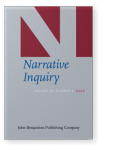Vol. 32:2 (2022) ► pp.362–392
Desire, liturgy, and the joint construction of narrative in a teacher preparation program
Treating narrative as a social practice has enabled examination of the identity work accomplished through interactive story construction within various communities, including teacher preparation programs. Largely unaddressed in this literature is the presence of desire – the sense of longing conveyed through expressed wants, wishes, and hopes – and how it works in and through narrative practice. Following James K. A. Smith (2009), I posit that some stories may be liturgical in their conscripting of tellers and listeners into narratives that shape their identities and direct their desires. To explore this empirically, I examined desire in the joint construction of a professional identity narrative – teacher as lifelong learner – within an urban teacher residency. My analysis suggests that program leaders’ expressed desires of and for the novice teachers established the leaders’ authority and worked to conscript novices into the narrative. However, novices were actively negotiating the narrative and the desirability of the professional identity.
Article outline
- Introduction
- Narrative as social practice
- Narrative as liturgy
- Study site and participants
- Methods
- Initial Analysis and Data Selection
- Approach for textual analysis
- Findings
- How speakers author(ize) narratives and desires
- How a community negotiates narrative and desire
- Vignette 1.Sharing mid-year perspectives on “continued growth”
- Vignette 2.Preparing to be “that candidate”
- Discussion
- Concluding thoughts
- Acknowledgments
- Notes
-
References
